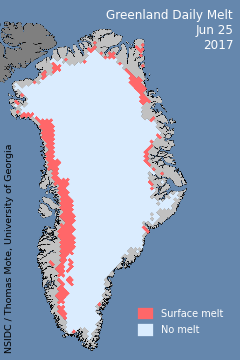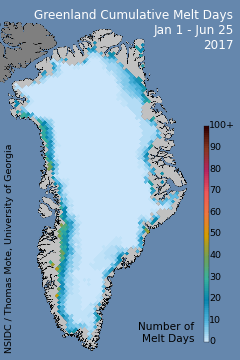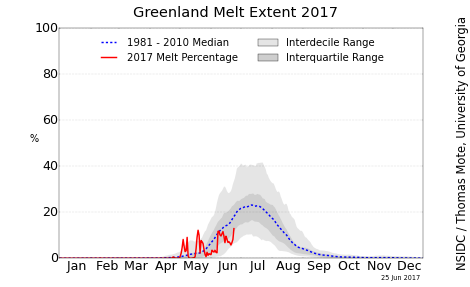Old Rocks
Diamond Member



Greenland Ice Sheet Today | Surface Melt Data presented by NSIDC
Very close to the record melt year of 2012.
Follow along with the video below to see how to install our site as a web app on your home screen.

Note: This feature currently requires accessing the site using the built-in Safari browser.



Do you know what an answer is?My God, how I envy your erudite answers.



Greenland Ice Sheet Today | Surface Melt Data presented by NSIDC
Very close to the record melt year of 2012.
It is amazing how easily duped warmers are.


Greenland Ice Sheet Today | Surface Melt Data presented by NSIDC
Very close to the record melt year of 2012.
When folks talk about "melt" -- like in your cited paper below -- you are EXAGGERATING greatly what the true meaning of that is. It is not even necessarily a permanent loss of ice. There are "days" of melt where the ice is RESTORED during the nights or the following days.
If you like SCARING folks into believing that 40% of Greenland is "melting" into the sea -- carry on. But it is fear-mongering to do so..
how does the ice from the process of sublimation make it to the ocean? me thinks you are cuckoo. Explain to the class how sublimation process the ice would get to the ocean.Sublimation or melt, the result is the same. The water ends up in the ocean. How do you 'greatly exaggerate' the measured amount of ice that is leaving Greenland every year? And how do you exaggerate the increase in that amount. And the measured increase in the rate of glacial flow into the ocean that we are seeing both in Greenland and Antarctica.
Mr. Flacaltenn, you are playing with words, trying to destroy their meaning.
Don't ask questions. You need to just BELIEVE!how does the ice from the process of sublimation make it to the ocean? me thinks you are cuckoo. Explain to the class how sublimation process the ice would get to the ocean.Sublimation or melt, the result is the same. The water ends up in the ocean. How do you 'greatly exaggerate' the measured amount of ice that is leaving Greenland every year? And how do you exaggerate the increase in that amount. And the measured increase in the rate of glacial flow into the ocean that we are seeing both in Greenland and Antarctica.
Mr. Flacaltenn, you are playing with words, trying to destroy their meaning.
he won't answer and I know it. I need an education as to how solids turned to vapor returning to solids makes it to the ocean. That's a new one.Don't ask questions. You need to just BELIEVE!how does the ice from the process of sublimation make it to the ocean? me thinks you are cuckoo. Explain to the class how sublimation process the ice would get to the ocean.Sublimation or melt, the result is the same. The water ends up in the ocean. How do you 'greatly exaggerate' the measured amount of ice that is leaving Greenland every year? And how do you exaggerate the increase in that amount. And the measured increase in the rate of glacial flow into the ocean that we are seeing both in Greenland and Antarctica.
Mr. Flacaltenn, you are playing with words, trying to destroy their meaning.
very carefullyHow did the tress grow under that ice in Greenland?
Ice caps, like glaciers, grow when the amount of new snow exceeds the amount of melt.